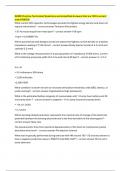Ibhre practice test - Study guides, Class notes & Summaries
Looking for the best study guides, study notes and summaries about Ibhre practice test? On this page you'll find 20 study documents about Ibhre practice test.
Page 2 out of 20 results
Sort by
IBHRE Practice Test Latest Questions and simplified Answers that are 100% correct and A+RATED
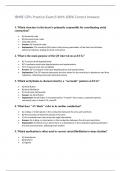
-
IBHRE CEPs Practice Exam 6 With 100% Correct Answers
- Exam (elaborations) • 7 pages • 2024
- Available in package deal
-
- $8.49
- + learn more
Which structure in the heart is primarily responsible for coordinating atrial contraction? • A) Sinoatrial node • B) Atrioventricular node • C) Bundle of His • Answer: A) Sinoatrial node • Explanation: The sinoatrial (SA) node is the primary pacemaker of the heart and initiates electrical impulses, leading to atrial contraction.
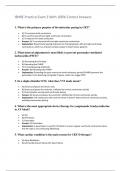
-
IBHRE Practice Exam 3 With 100% Correct Answers
- Exam (elaborations) • 7 pages • 2024
- Available in package deal
-
- $8.49
- + learn more
What is the primary purpose of biventricular pacing in CRT? • A) To increase atrial contraction • B) To synchronize left and right ventricular contraction • C) To improve AV node conduction • Answer: B) To synchronize left and right ventricular contraction • Explanation: Biventricular pacing improves the timing between left and right ventricular contractions, which can enhance cardiac output in heart failure patients.
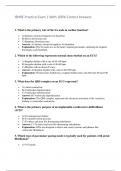
-
IBHRE Practice Exam 1 With 100% Correct Answers
- Exam (elaborations) • 7 pages • 2024
- Available in package deal
-
- $8.49
- + learn more
What is the primary role of the SA node in cardiac function? • A) Initiates electrical impulses for heartbeat • B) Slows down heart rate • C) Regulates blood pressure • Answer: A) Initiates electrical impulses for heartbeat • Explanation: The SA node acts as the heart's natural pacemaker, initiating the impulse that begins each heartbeat.
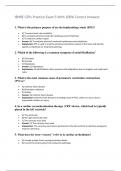
-
IBHRE CEPs Practice Exam 5 With 100% Correct Answers
- Exam (elaborations) • 7 pages • 2024
- Available in package deal
-
- $8.49
- + learn more
What is the primary purpose of an electrophysiology study (EPS)? • A) To assess heart rate variability • B) To evaluate electrical conduction pathways and arrhythmias • C) To measure cardiac output • Answer: B) To evaluate electrical conduction pathways and arrhythmias • Explanation: EPS is used to map the electrical conduction system of the heart and identify specific arrhythmias for treatment planning.
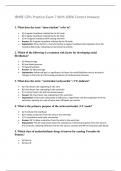
-
IBHRE CEPs Practice Exam 7 With 100% Correct Answers
- Exam (elaborations) • 7 pages • 2024
- Available in package deal
-
- $8.49
- + learn more
What does the term "sinus rhythm" refer to? • A) A regular heartbeat initiated by the AV node • B) A regular heartbeat initiated by the SA node • C) An irregular heartbeat with varying intervals • Answer: B) A regular heartbeat initiated by the SA node • Explanation: Sinus rhythm is characterized by a regular heartbeat that originates from the sinoatrial (SA) node, indicating normal electrical activity.
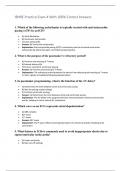
-
IBHRE Practice Exam 4 With 100% Correct Answers
- Exam (elaborations) • 6 pages • 2024
- Available in package deal
-
- $8.49
- + learn more
Which of the following arrhythmias is typically treated with anti-tachycardia pacing (ATP) by an ICD? • A) Atrial fibrillation • B) Ventricular tachycardia • C) Sinus tachycardia • Answer: B) Ventricular tachycardia • Explanation: Anti-tachycardia pacing (ATP) is commonly used to terminate ventricular tachycardia by delivering rapid, controlled pacing impulses.
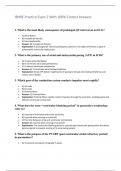
-
IBHRE Practice Exam 2 With 100% Correct Answers
- Exam (elaborations) • 6 pages • 2024
- Available in package deal
-
- $8.49
- + learn more
What is the most likely consequence of prolonged QT interval on an ECG? • A) Atrial flutter • B) Torsades de Pointes • C) Sinus bradycardia • Answer: B) Torsades de Pointes • Explanation: A prolonged QT interval predisposes patients to Torsades de Pointes, a type of polymorphic ventricular tachycardia.
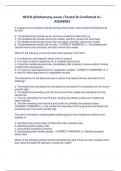
-
BHRE PRACTICE TEST//BASED WITH EVIDENCE ,PRACTICE 2024-2025.
- Exam (elaborations) • 20 pages • 2024
-
- $18.49
- + learn more
IBHRE PRACTICE TEST//BASED WITH EVIDENCE ,PRACTICE . What is the goal of optimizing via echo for AV delay and ventricular synchrony? - CORRECT ANSWERS -E and A waves separating with the end of diastole coinciding with beginning of systole What lab finding indicates HF exasperation? - CORRECT ANSWERS -Elevated BMP What heart failure approved drugs have shown an increase in survival and EF? - CORRECT ANSWERS -Carvedilol and metoprolol Which study demonstrated a clear mortality benefit from...
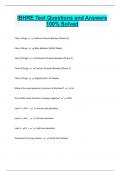
-
COMPLETE BUNDLE;;; IBHRE BUNDLED EXAMS WITH COMPLETE SOLUTIONS
- Package deal • 49 items • 2024
-
- $50.99
- + learn more
IBHRE Study Guide: Equations Questions and Answers 100% Solved 2 Exam (elaborations) IBHRE Surgical Techniques Questions and Answers 100% Solved 3 Exam (elaborations) IBHRE ATI Practice Test Questions and Answers 100% Solved 4 Exam (elaborations) IBHRE Study Material: GTP Trivia Questions and Answers 100% Solved 5 Exam (elaborations) IBHRE CCDS

Did you know that on average a seller on Stuvia earns $82 per month selling study resources? Hmm, hint, hint. Discover all about earning on Stuvia

